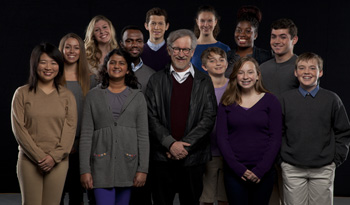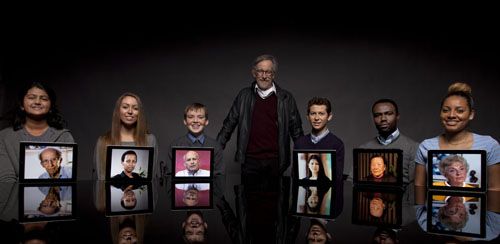
The PastForward Cover Students
Twenty years ago, David Strick photographed Steven Spielberg surrounded by 12 Holocaust survivors – illustrating in a single frame the work and mission of the newly-founded Survivors of the Shoah Visual History Foundation.
On a cool day this January, Spielberg again posed for a photo by Strick; only this time, students from middle school to college stood around him. This is the Shoah Foundation today.
Hailing from Los Angeles-area schools and the University of Southern California, the students have all been touched by testimony from USC Shoah Foundation’s Visual History Archive. The five middle school students and two of the high school students watch testimony of Holocaust survivors in IWitness in their history classes and have participated in the IWitness Video Challenge, which encourages students to be inspired by testimony to perform community service projects in their own communities.
Three of the high school students watched Shoah Foundation testimony as part of the Anti-Defamation League (ADL)’s Grosfeld Family National Youth Leadership Mission, which gathers high school juniors with leadership potential from around the country to learn about prejudice. The USC students are all interns in USC Shoah Foundation’s communications and ITS departments.
The students arrived early to a soundstage at Universal Studios for the four-hour shoot, which would also include a second photograph featuring Spielberg and six of the students seated at a table with iPads in front of them displaying faces from each of the Shoah Foundation’s six testimony collections (two Holocaust, Rwanda, Nanjing, Armenia and Cambodia). Both photographs are featured in the Spring 2014 issue of PastForward, the Institute's digest.
During the shoot, the students spoke eagerly about their experiences watching testimony.
Victor Ewubor interned in the ITS department, helping to restore damaged testimonies, and recently graduated from USC with a master’s degree in engineering. He said it was “striking” to see how genocide survivors talk about forgiveness in their testimonies.

“The human spirit came out even stronger, regardless of what they had lost,” Ewubor said. “They just moved on with life.”
Kamerie Gibson, a high school junior, said she didn’t know very much about genocide before watching Shoah Foundation testimony.
“It exposed me to things I didn’t know were going on in the world. It taught me that the words we use are the building blocks to what the world we live in might be like,” Gibson said.
Other students recalled specific testimonies that had moved them – seventh-grader Tara Adarkar said one story about a dog who learned more easily than Nazis to trust Jews was particularly memorable – and said listening to the tales of survival were inspiring and heartbreaking at the same time.
Three of the students have a family connection to the Holocaust and find testimony a powerful and personal way to learn more about what their relatives went through.
When Spielberg arrived at the shoot, the students greeted him at the door and introduced themselves. After the last frame had been shot, Spielberg asked the students how they had been affected by testimony.
Alex Biniaz-Harris, a Shoah Foundation intern, said his grandmother, Celina Biniaz, would never have spoken about her experiences as a member of “Oskar Schindler’s list” if she hadn’t had the opportunity to record testimony for the Shoah Foundation.
Eighth-grader Corah Forrester said, “I got to feel an emotional link between the survivor and myself that made me connect more to the experience, because I could hear the emotion in what they were saying.”
Spielberg thanked the students for participating, and executive director Stephen Smith asked them how the Shoah Foundation might be able to improve their experience watching testimony.
Their suggestions illustrated just how far the Shoah Foundation has come since that photo shoot 20 years ago. They want to be able to watch testimony on their iPhones.